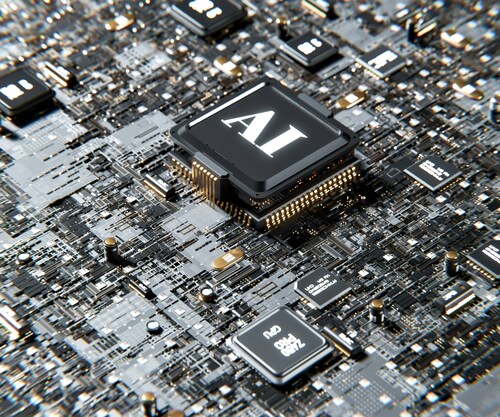To guarantee quality, dependability, and efficiency, the swift advancement of software development necessitates equally complex testing methodologies. Modern agile and DevOps workflows frequently outpace traditional testing methods despite their effectiveness because of the shorter release cycles and growing complexity of applications. AI in testing enters the picture here. AI is revolutionizing software testing by utilizing machine learning (ML) algorithms, which make software testing faster, more accurate, and highly adaptable to complex systems.
Through repetitive task automation, processing large amounts of data, and anticipating potential failures, AI in testing has the potential to enhance software quality at the cost of less human effort. Also, AI enables wise decision-making and anticipatory fault discovery, moving testing from the reactive to continuous and adaptive domain. Moreover, by identifying segments of an application requiring deeper exploration, AI is capable of enhancing exploratory testing.
AI can identify possible risk factors that manual testing might miss by utilizing pattern recognition and predictive analytics. Bots with AI capabilities can also replicate user interactions at scale, spotting edge cases that conventional approaches might overlook. The integration of AI with cloud environments is another important feature that facilitates distributed testing across various platforms and devices. Tests can be run concurrently in several environments using AI-driven test frameworks, guaranteeing compatibility and performance consistency.
The Role of AI in Testing
From the creation of test cases to the prediction of defects, artificial intelligence is revolutionizing software testing. AI is having an impact in the following ways.
The creation of intelligent test cases: The conventional method of creating test cases is laborious and prone to human error. AI-powered solutions can automatically create effective test scenarios by analyzing system logs, previous test cases, and application requirements. This increases test coverage and decreases the amount of manual labor required to maintain test scripts.
Test Automation: That Heals Itself. Due to frequent changes in functionality and user interface, automated tests frequently fail. AI-driven self-healing test automation prevents test failures and lowers maintenance costs by dynamically modifying scripts in response to changes in user interface elements.
Analyzing the root cause and predicting defects: Previous data can be analyzed by machine learning models to find trends that result in flaws. Teams can proactively address problems before they affect the system as a result. Additionally, by finding connections between code modifications and persistent flaws, AI can carry out root cause analysis.
Smart Optimization and Test Execution: AI prioritizes test cases according to risk assessment, which improves test execution. By concentrating on high-impact areas rather than running the complete test suite, AI-driven test selection shortens execution times without sacrificing software quality.
Automated Visual Examination: By contrasting screenshots and emphasizing differences, AI-powered visual validation tools can identify UI inconsistencies. AI-based visual testing recognizes layout font and color variations to guarantee a consistent user experience in contrast to conventional pixel-by-pixel comparison techniques.
AI-Assisted Performance Evaluation: AI can forecast system behavior in various scenarios and replicate real-world traffic patterns. It assists in locating performance snags and offers optimization techniques to improve the scalability and responsiveness of software.
The Benefits of AI in Software Testing
The adoption of AI in testing offers several advantages:
Quicker Testing Cycles
From the abovementioned points, it can be concluded that AI helps to save time on testing and increase test throughput. Since the testing frameworks are intelligent, and they are capable of creating and executing thousands of tests at once, the time taken for extensive testing is drastically shortened.
Whereas, by using historical results, it is known which test cases have the potential to expose defects, thus AI shortens the time of test execution. It makes the overall production rate improve since the system focuses on areas likely to cause nearly half of the accidents while reducing the cycle time in agile development iterations for software development.
Improved Accuracy
AI enhances its effectiveness when it comes to deficit detection, and as it does not involve human interference, the level of accuracy is highly boosted. In their usage, AI algorithms improve their capacity to identify various types of faults and other issues in the tested programs as they gradually learn new test results from the previous test exercises. To increase the reliability of tests, it is important to eliminate false-positive and false-negative results and also look for certain patterns in the outcomes and repeating issues. AI can also verify various test parameters, which are the indications of a defect on different hardware/firmware/OS tool platforms. The use of Artificial Intelligence will make testing results more trusted by the testing team, hence making the release of software more stable and reliable.
Cost-effectiveness
Artificial intelligence reduces manual labor and maintenance, which lowers overall test costs. Teams can focus on more important duties like exploratory and security testing since AI-driven automation reduces the need for highly skilled manual testing labor. Furthermore, by optimizing the execution of low-value or duplicate test cases and lowering the infrastructure costs related to running large test suites, AI can save test execution expenses.
Additionally, by anticipating possible flaws in the early stages of development and avoiding expensive post-launch repairs, predictive analytics increases cost-effectiveness. In the end, automated testing with artificial intelligence lowers costs significantly by improving test efficiency, decreasing downtime, and accelerating product delivery.
Improved Test Coverage
AI-based approaches ensure comprehensive validation, including edge cases. With application behavior analysis, untested scenario test case generation, and gap analysis of existing test suites, AI enhances test coverage. By using AI-based analytics, teams can achieve more comprehensive validation on multiple devices, browsers, and environments. AI is also capable of simulating complex user interactions, ensuring that software functions correctly in a range of situations, including rare and unexpected edge cases that traditional testing may overlook.
Continuous Testing in DevOps
Continuous testing is supported by the smooth integration of AIs with CI/CD pipelines, allowing DevOps deployments as frequently as needed. AI-powered test automation makes it feasible to run tests immediately following code changes, guaranteeing immediate feedback and early defect detection. By improving test case selection and concurrent execution across environments artificial intelligence (AI) improves test orchestration. AI-based monitoring tools can also analyze production data in real-time anticipating possible failures and actively reducing risks before they affect users. This ongoing verification ensures software quality and stability in rapid DevOps processes.
Challenges and Considerations
Despite its potential, implementing AI in testing comes with challenges:
Initial Investment: The resources and infrastructure required by AI-based tools, including the processing power required, training an AI model, and integration of the existing test environment, would demand a major investment. Implanting AI-based testing mandates organizations to examine the long-term ROI.
Dependency on Data Quality: Data Quality Dependence: Machine learning models depend on high-quality, correctly labeled data to make precise predictions. Erroneous data can produce inconclusive test results, and thus, the data needs to be constantly curated and optimized.
Skill Gap: To appropriately leverage AI-based testing tools, test engineers must gain expertise in AI and ML technologies. To fill the gap between AI-driven testing and traditional QA, organizations must hire AI specialists or go for training programs.
Interpretability of AI Decisions: Identifying the interpretability of AI test decisions may be difficult, requiring understandable and explainable models. Explainable AI (XAI) constitutes a key area of concern for AI-based testing solutions because reliability and trust are based on the interpretability of test output generated by AI.
How LambdaTest is Revolutionizing AI-Driven Software Testing
LambdaTest is an AI-native test execution platform using artificial intelligence where developers and QA engineers can run automated tests against over 3000 environments, including actual environments.LambdaTest is a leading provider of AI-powered software testing through the use of artificial intelligence to improve automated testing, acceleration execution, and precision of tests.
Here’s how LambdaTest is helping in AI for software testing:
AI-Powered Test Execution: By selecting test cases intelligently using prior data and priority risk analysis, LambdaTest leverages AI to optimize test execution across cloud infrastructure.
Smart Test Orchestration: Customers can run concurrent tests on thousands of real browser devices and operating systems thanks to intelligent test orchestration, which is supported by artificial intelligence. This reduces execution time and improves test coverage.
Self-Healing Test Mechanisms: By automatically updating test scripts and keeping track of user interface changes in web applications, artificial intelligence (AI) facilitates self-healing test automation and gets rid of fragile test failures.
Visual AI Testing: AI-powered visual testing is integrated by LambdaTest to identify user interface (UI) inconsistencies across various devices and browsers, guaranteeing a smooth user experience. Orchestration of Smart Tests.
Intelligent Debugging: By using AI-powered log analysis, LambdaTest helps quickly detect test failures and offers insightful analysis and automated debugging suggestions.
Predictive Test Analytics: LambdaTests AI enables predictive test analytics by identifying patterns in test failures. This allows QA teams to proactively address possible flaws before they have an impact on production.
Conclusion
AI testing is transforming software quality assurance and is no longer a science fiction concept. AI is enhancing the intelligence, velocity, and reliability of testing by automating challenging tasks, predicting defects, and optimizing test execution. Companies can accelerate release cycles, enhance software stability, and improve test accuracy by effectively adopting AI-based testing. Since AI enables predictive analytics, real-time feedback, and smart test upkeep, it is also greatly increasing the agility and resilience of software development.
As artificial intelligence-based test tools continue to develop, they will increasingly cut down on human intervention while augmenting the breadth and depth of software validation. Ongoing R&D in artificial intelligence-based test solutions is fixing problems such as data dependency, explainability of AI models, and the need for skilled people. Artificial intelligence-based quality assurance will provide organizations with a huge competitive advantage by ensuring improved software quality, reduced costs, and a faster time to market.
To stay ahead, AI-driven testing procedures must be optimized through the use of AI-driven analytics and ongoing machine learning model improvement. In addition to changing testing, AI is also affecting software development as a whole. Artificial intelligence is improving the intelligence, speed, and reliability of testing by automating difficult jobs, predicting errors, and speeding up test execution. Businesses may improve test accuracy, speed up release cycles, and increase software stability by successfully implementing AI-driven testing.










